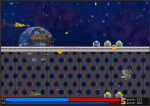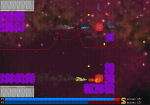Shoot ‘Em Up! (afterthoughts on an experimental flash game)
It's about the design, development and afterthoughts on an experimental flash game I made in my spare time in 2012, when I was fairly new to game development.

The following post was originally posted on stevencraeynest.wordpress.com on April 13, 2013.
---------------
I never play much casual or web based games,
but I do visit Kongregate every so often (though it has been a while),
because they tend to have more original games than the average flash games site.
(or atleast they used to)
I also made some small games available there, mostly fairly rough, not-quite-finished games.
But an other one is Shoot ‘Em Up, which this post is obviously about.
One thing I liked about making games for use on Kongregate, are the APIs.
(To be honest though, I’ve never uploaded my flash games anywhere else, so I don’t know what it’s like on other sites)
One of the APIs is the “Shared Content API”, which allowed users to save content they made in a game, and let others load it.
Mostly used for sharing save games and creating custom levels.
But I started thinking of ways to use the API for more direct gameplay mechanics, for creating a more cooperative gaming experience.
The Concept
I got the idea to make a 2 player co-op game, where instead of 2 players playing simultaniously, only 1 player playes at a time, and the other is a recorded run of someone else.
And after finishing a level, the player could then save his run, and share it with others so they could then play co-op with it.
The idea was to see if this concept could allow for a new interesting experience, given the advantages and disadvantages that come with it.
The main advantages beeing that it allowed players to play together without having to play at the same time, and that any single run could be used for any number of different players, both friends and strangers.
(and smaller advantages beeing the impossibility of there beeing server or connection problems)

Since it was gonna be an experiment, I decided it should be a fairly simple game, not too big and easily accessible.
A 2D Shoot-em-up with pixel graphics seemed to be a good choice, as that’s one of the more easy games to make.
…
Well that turned out quite differently.
The Development
I liked making different ennemies, bosses and weapons too much, so it caused me to make the game at lot bigger and complexer than originally planned.
The graphics style was indeed fairly easy to make, but that only caused me to make more and more content.
Other than that, it also proved very difficult to explain the game mechanics in simple and clear ways to the player.
I wanted to emphasise the co-op element of the game, so I tried to make it really about cooperation.
I didn’t want it to be just 2 players shooting trough enemy waves, ignoring each other, I wanted them to help each other and work together.
Now how do you do that when 1 of them is a predetermined recorded run?
Well the biggest ellement I added for that purpose was the gates and gate switches;
some levels where devided in 2 parts, 1 for each player, with gates blocking their paths and gate switches that opened the gate when shot, but the key beeing that the switches for Player1’s gates where in Player2’s part and vica versa.
And another was a weapon, the helix cannon.
It shoots a beam of red and blue particles, that can move through walls, in a sin-like wave.
But when both players had this weapon equipped, their beams would be drawn towards and spiral around each other. Beacuse of this the players really had to keep track of each other and act in accordance.
The Problems
Having one player beeing completely predetermined causes some issues ofcourse, I anticipated this, but the gravity of it was still much bigger than expected.
Simply put, everything that makes a playthrough different from the playthrough of the recorded run, can cause the recorded player to behave illogically.
For one, this means nothing should happen, even partially, at random. Everything must happen exactly the same each time (except for the active player), otherwise the recorded run would make no sense.
And all the enemies that target a player, always have to target either player1 or player2, they can’t change this based on whoever is closest, cause this would further differentiate it from the recorded run, this unfortunately limits the enemy behaviour.
An issue that can’t be helped, is that when the active player kills an enemy (that wasn’t killed in the recorded version), the recorded player might still try to shoot it down,
and worse, when the active player fails to kill en enemy fast enough (that was killed in the recorded version), the recorded player might fly into it (causing massive damage to the player).
The designs of the levels, and the gates and gate switches, had to be severly simplified,
because originally there where gate switches that both closed gates and opened others, but the problem with this was that it could cause the recorded player to fly straight into a gate, killing him instantly.
And the gate HAS to kill him instantly, as it is a recorded run, and so the only alternative would be making him fly through the gate.
The Result
All in all, I like how the game ended up, though I do not consider it a succes.
The concept has it’s plus sides, but IMO they don’t really outweight the downsides.
The problem basically comes down this:
It’s supposed to be a cooperative game, and that really requires interaction between the 2 players,
but there can’t be interaction when one is prerecorded, there can only be reaction.
It was an experiment, and although it wasn’t a great succes, an experiment is only a failure when you fail to learn from it.
You can play the game here:
http://www.kongregate.com/games/Stef1987/shoot-em-up
(But make sure to read the instructions before you start.)
You can only share your run when you have a Kongregate account (don’t worry, it’s free)
Read more about:
BlogsAbout the Author(s)
You May Also Like


























.jpeg?width=700&auto=webp&quality=80&disable=upscale)








